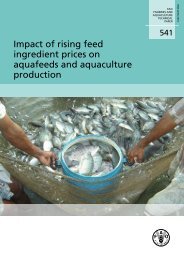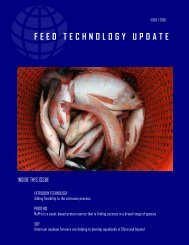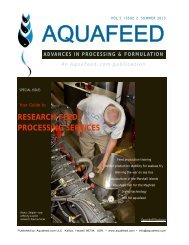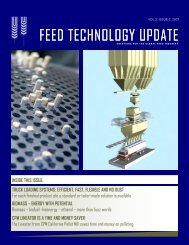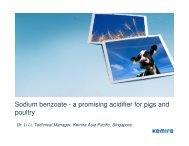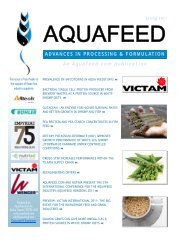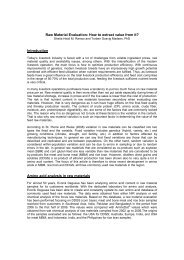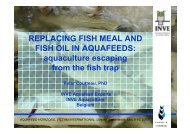FEED TECHNOLOGY UPDATE - AquaFeed.com
FEED TECHNOLOGY UPDATE - AquaFeed.com
FEED TECHNOLOGY UPDATE - AquaFeed.com
Create successful ePaper yourself
Turn your PDF publications into a flip-book with our unique Google optimized e-Paper software.
DENSITY CONTROL<br />
Density control and process optimization<br />
for extruded aquatic feeds<br />
The effect of formulation and process variables on finished<br />
product density<br />
By Galen J. Rokey and Brian S. Plattner, Wenger Manufacturing, Inc.<br />
A<br />
n aquatic feed’s density<br />
is a critical <strong>com</strong>ponent<br />
as it impacts<br />
many things including<br />
plant capacity, floating<br />
and sinking properties, product<br />
appearance, and absorption<br />
of external coatings.<br />
However, the pellets’ floating<br />
or sinking properties are often<br />
the most critical functional<br />
characteristics as the<br />
feed buoyancy impacts both<br />
the aquatic animal's nutrition<br />
as well as the aquaculture<br />
environment.<br />
The buoyancy of aquatic feed is easily correlated<br />
with bulk density, as shown in<br />
Table 1.<br />
Controlling the density during extrusion can<br />
often be a challenge due to the many process<br />
variables which can be manipulated.<br />
In an earlier article “Adding Flexibility to<br />
the Extrusion Process” [FTU - January,<br />
Table 1:<br />
Final Product Bulk Density Correlation with<br />
float-sink properties for Aquatic Feeds<br />
Feed<br />
characteristics<br />
Sea water @<br />
20ºC .<br />
(3% salinity)<br />
Fresh water<br />
@ 20ºC<br />
Fast-sinking >640 g/l >600 g/l<br />
Slow-sinking 580-600 g/l 540-560 g/l<br />
Neutral 520-540 g/l 480-500 g/l<br />
buoyancy<br />
Floating



